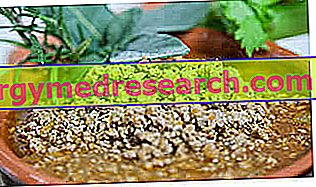Generality
Ragù is a sauce intended to accompany first courses based on: pasta (dry, fresh, stuffed), gnocchi or polenta; other recipes with ragù are the stuffed Sicilian arancini, the bruschette etc.

The term "ragù" constitutes the Italianization of the French noun " ragoût ", meaning "appetente". Indeed, in France the ragoût is a dish based on stewed meat MA is far from the function of the Italian sauce, instead destined exclusively to the accompaniment of first courses or unique dishes.
Traditional recipe from Bologna
The most famous Italian ragù in the world is undoubtedly the Bolognese ragù; the Neapolitan ragù, Romagna and Marche are also well known. In reality, the variations of the ragù are the fruit of the combinations between the various ingredients according to the geographical locations; it goes without saying that this is a practically immeasurable repertoire.
The Bolognese ragù recipe is anything but secret. The ingredients are: sauté: onion, carrot, oil, butter; ground beef, minced pork, fresh minced pork bacon; Red wine; tomato paste, broth, salt, ground pepper and a glass of milk. The procedure is simple but rather long: fry carrot and onion in oil and butter, add the bacon and brown it; then the minced meat and brown it; blend with the wine and let it evaporate; continue with the broth for about 2 hours; add milk and reduce; adjust flavor with salt and pepper.
Although it all seems very clear, this recipe is far too approximate, since some details are omitted to say the least SUBSTANTIAL; in the next paragraph we will explain better what.
The True Nature of Ragù
What people don't remember
First of all, in the various recipes for meat sauce, very fresh and top quality ingredients are always suggested. Huge mistake! A good meat sauce, if you prefer, in addition to being GREASE, requires the use of raw ESUBERS of other more "noble" preparations. Originally, this recipe (like many others in the home tradition) represented a source of "second best" for: butcher cuts or, to the extent, less fine pieces * ; waste from the garden; the "less pleasant" products of the cellar. Ultimately, the ragù itself, although having the same procedure, NEVER possesses the same identical taste.
All the small pieces of trimming of pork and beef are part of the ragù, better if deprived of the most difficult connective tissues (skin, cartilage, tendons, muscular sheaths); there is no shortage of surplus sausage / salami dough (or slightly dark sausages, perhaps dried, but still fragrant), pieces of bacon, ham fat, etc.
Obviously, the same is true for vegetables, broth, wine and tomato. In the sauce, scraps of onion, celery and carrots that are partially wasted or not otherwise usable are used. The portions of vegetables even less "in shape" (however edible), together with some bones that the butcher supplies (or better, should provide ...) FREE, will be used for the broth. Needless to say, opening a can of preserves for ragù is certainly the last resort; some remnants of the vegetable garden can fulfill its purpose perfectly.
The wine must be homemade, dry or soft according to availability (the "good" wine is never used to make ragù, always the "saddest or slightly vanished" ... but ATTENTION! It must not be ACETOUS! ).
The real difficulty in formulating a good meat sauce is to get the maximum taste with the least expense. The ragù must cost VERY time and effort (see the cleaning and cleaning of vegetables and meat or the preparation of the broth), BUT very little money!
All this is then enhanced by the cooking technique. Many readers will be stunned to learn that, at one time, for a few months a year, cooking food had a cost of 0. In fact, the economic kitchen was used, that is the stove that was also turned on to heat the room (more rarely the cauldron on the fireplace). The heat was regulated by adding more or less wood (obviously obtained from the mowing of the surrounding plots of land) and, if the heat was low, cooking continued even half a day. Needless to say, with this method, both the broth (whose surplus would have been the next meal) and the ragù, acquire a delicious and totally unknown flavor to today's gourmets.
Last but not least, the cooking pan. For the particular ability to transmit heat, it would be appropriate to choose those in terra cotta.
The conviction that for a good ragù is necessary to use first choice ingredients is therefore completely wrong; it is not uncommon for some "caring mothers" to choose loins, walnuts or even veal fillets to be ground for the sauce. To these I remind you that lean meat does NOT lend itself to this purpose; the excess fat can be eliminated from the "heavy" sauce thanks to the surfacing that occurs both during cooking and when cold. However, it would not be a "light" food but, trust me, it is better to enjoy the ragù once a month but eat it good, rather than sipping 2-3 times a week a "stringy" meat sauce drowned in the tomato !
NB . Again for informative clarity, the same recovery techniques for foods that are deteriorating (which, from my point of view, are a real art) are used by ALMOST ALL the restaurateurs (especially those famous for their excellent ragù); those who do not adopt these strategies and prefer the size of whole meat do so only for economic reasons, or in the case where the work of the kitchen technician COSTI of MORE than the saving of the raw material. Practically:
- If to get 10kg of ragù with recycled raw materials I spend € 5 on ingredients, gas, water and electricity + € 15 of labor = € 25
- and to get 10kg of ragout with raw materials ready to use I spend 10 € of ingredients, gas, water and electricity + 5 € of labor = 20 €
it is logical to think that we should choose the second option instead of the first one.
Variations of Ragù Bolognese
Compared to the traditional recipe of Bolognese sauce, there are many regional, provincial and even municipal variants. Without going into the details of "who uses what", we briefly list some possibilities for modifying the preparation.
First of all, it is a fairly common habit to use shallots instead of onion in a light sauce, also enriched with a clove of garlic to be removed before adding the meat. Then, in the preparation of the sauce, you can choose: just butter, only oil, or lard (alternatively, the fat of ham without rind and, above all, FREE OF SUGNA! ).
The fat component of the meat can be managed in many ways. Instead of bacon, you can use sausage, tasta-salt or a lard cube; better still, it is possible to choose already quite fatty pieces and at that point it would no longer be necessary to add bacon, sausage or lard.
Meat ragout LIGHT - No added fat
X Problems with video playback? Reload from YouTube Go to Video Page Go to Video Recipes Section Watch the video on youtubeSee also the vegan variant without cholesterol: seitan vegetable ragout
As for the wine, many prefer the white one instead of the red one, instead not replaceable in the beef sauce ONLY.
The tomato is undoubtedly an ingredient excluded from the white ragù, but for the red ones the choice of the product significantly changes the pace of the recipe.
 | |||||||||||||||||||||||||||||||||||||||||||||||||||||||||||||||||||||||||||||||||||||||||||||||||||||||||||||||||||||||||||||||||||||||
Nutritional values (per 100 g of edible portion)
| |||||||||||||||||||||||||||||||||||||||||||||||||||||||||||||||||||||||||||||||||||||||||||||||||||||||||||||||||||||||||||||||||||||||
It is quite convenient to use the concentrate, as it does not require the correction of acidity and does not increase the wateriness of the sauce. On the other hand, a tomato sauce already flavored or fresh ripe tomatoes (like S. Marzano) could give "a plus" to the sauce.
Perhaps the use of spices and aromatic herbs is the major variable among all those listed. Only the black pepper is included in the traditional Bolognese recipe; however, bay leaves, bay leaves and rosemary are also very common. Less used, but still present: juniper berries, cloves and basil.
The use of milk is quite controversial and depends essentially on the type of preparation to be obtained. The milk softens the taste of the sauce a lot, clarifies it and reduces its acidity; obviously, it does not lend itself to complete shaded ragùs with particularly full-bodied wines (eg a structured Sangiovese).
Finally, I add a personal advice; for sheep meat lovers, adding two or three bones of mutton or lamb during the cooking of the meat sauce will lead to an excellent result to say the least.
Nutritional characteristics
Ragù alla Bolognese is a decidedly high-calorie sauce rich in saturated fats * . It does not lend itself to customary nutrition and even less to that of those who suffer from overweight and / or hypercholesterolemia. Furthermore, it is a product that is quite difficult to digest; it is therefore logical to exclude it from the diet against gastritis, hypochloridria, hypercloridria, gastro-esophageal reflux (especially in evening meals) and in the diet of the elderly.
We also remember that the nutritional values shown in the table refer to the nutritional translation of the ingredients used and not to the finished ragout, much less rich in water and more concentrated.
Among the mineral salts there is no shortage of iron, potassium and calcium (from butter and milk). As for the vitamins, thiamine (vit. B1), niacin (vit. PP) and vitamin A are well present.



